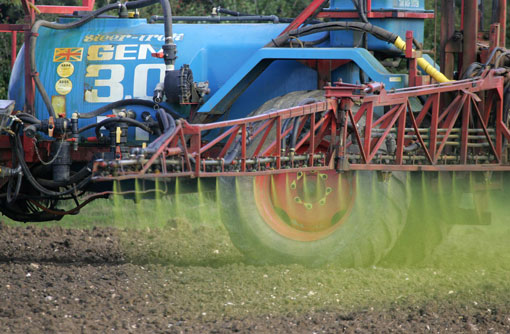Seven tips to get the most from pre-em herbicides

Given that pre-emergence herbicides can provide up to 80% weed control, Bayer CropScience surveyed growers and expertsto find out what they consider crucial considerations to ensure that herbicide programmes get off to a flying start.
1) Choose an effective pre-emergence…
Essex arable farmer James Nott takes a “belt-and-braces” approach to weed control. With increasing blackgrass pressure in all fields, Mr Nott has gone “all out with pre-ems” over the past five years.
“Pre-ems are one of the most important aspects of weed control,” says Mr Nott. “Choosing the right one is critical; you must look at them as an investment. They take the pressure off the post-ems, doing more than their fair share of control – between 60% and 80% in many cases.
“I talk to my agronomists in the first instance. We take into account the weed spectrum – although these days that is dominated by blackgrass – as well as the point in the rotation, the post-ems we’ll want to use and our previous experience with different products.
“To tackle blackgrass, flufenacet is the main active substance that our pre-em stacks are based on, adding either extra diflufenican or pendimethalin.”
2) …with least crop damage
Independent agronomist Patrick Stephenson is mindful of crop damage. “The pre-ems that contain pendimethalin can be a little hot, especially if there is an onset of heavy rain or if drilling has been variable. Ensuring the seed has been sown at the necessary depth and is well covered is the starting point to ensure the crop is as strong and tolerant as possible,” he says.
“Some wheat varieties are susceptible to chlorotoluron and while it is clearly stated on all the labels, there have been instances where a lack of communication between driller and sprayer has meant that it has been applied to a susceptible crop, causing severe damage.
“Whatever a grower chooses, they must bear in mind that our main arable crops are closely related to the target weed species. Unfavourable weather and a hot pre-em can thin the crop and reduce yields,” he warns.
3) Consider tank-mixing
Philip Spencer of Fieldfare Agriculture says it is imperative to consider tank-mixing pre-ems and harnessing the power of different modes of action. “Flufenacet is the most important starting point,” says Mr Spencer. “It is the most active against resistant blackgrass.
“Depending upon target weeds and circumstances, this can be topped up with either extra diflufenican, pendimethalin or flurtamone. Pendimethalin is great for targeting cleavers, but some of our blackgrass is now becoming resistant to this active. Flurtamone is good for boosting ryegrass control. All three of these tank-mixes enhance broad-leaved weed control too.”
4) Prepare a fine consolidated seed-bed
Mark Hemmant, Agrovista technical manager, says the importance of fine consolidated seed-beds is clear. “Applications will be more even on a fine consolidated seed-bed, so you’ll get better coverage. If large clods are left there is the risk they will break down over the course of a season, releasing seed which germinates when the pre-em has run out of steam.
“Open, wet seed-beds lead to an increased risk of crop damage, so for strong crop establishment and for pre-em efficacy a well-prepared, fine consolidated seed-bed is very important.”
5) Remove straw
Philip Wright of Wright Resolutions explains that taking the decision to remove concentrations of straw and chaff is a complex balancing act. The nutritional and structural benefits of allowing it to biodegrade, the cost of removal, straw prices and achieving optimum efficacy of pre-em products all have to be considered.
“Concentrations of straw can soak up active substances and prevent products from reaching the rooting zone,” he says. “Achieving sufficient pre-em efficacy while still leaving weed seeds on the surface where germination is kickstarted by UV light is possible – generally by straw removal or very effective chopping and spreading, followed by surface raking.
“Alternatively, growers can prepare a deeper seed-bed, which buries the straw or trash.”
6) Timing
Sean MacGill, commercial technical manager at Bayer CropScience, says it’s important to ensure the weeds’ roots are in the chemical zone or being forced to grow through it – it’s a factor critical to the efficacy of most pre-ems.
“Once the soil has settled following drilling, at pre-emergence you are trying to create a barrier to the weeds. Within 48 hours of drilling is perfect because the grass weeds are unlikely to have emerged. Those seeds lying under the layer of treated soil will have to grow up through the barrier, or, if the seeds are above the layer, their roots will grow down into the zone of soil containing the active substances.
7) Do not disturb the soil
Andrew Ward, a previous Cereals Event host, farms 650ha in Lincolnshire. “It’s not one thing that is important but every single detail, from the preparation of the seed-bed to nozzle choice and speed of the sprayer. This applies to post-em products too.
“Once a seed-bed has been prepared and drilled, the pre-ems seal the soil surface. You have created a barrier and any disruption to the soil surface will break this, risking the efficacy of any product. There is no good reason to go on again, everything should have been prepared prior to drilling and the pre-em application.
“We have some fantastic products at our disposal, but we can’t expect them to perform if we haven’t given them a chance and used them in the way that they have been developed to be used.”

